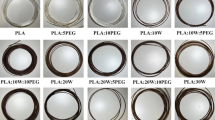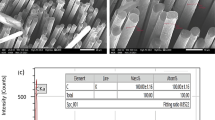Abstract
Polylactic acid (PLA) and wood composites as biodegradable materials have limited applications due to the poor dispersity of wood flour (WF) in PLA matrix and weak adhesion. Thus, this study aims to prepare PLA/WF composite materials by combining high-temperature moist air (220 °C), A-187 silane coupling agent, and acetic anhydride with PLA and employing heat treatment (HT) and esterification methods. The effects of different treatment methods on the crystallization, thermal and mechanical properties, and hydrophobicity of the WF/PLA composites are studied. The addition of heat-treated esterified WF decreases the cold crystallization temperature, thermal stability, and water resistance of the composites. Compared with the untreated WF/PLA composite, the heat-treated esterified WF/PLA composite has 40% increase in tensile strength and 13% increase in flexural strength. HT combined with other modification methods significantly reduce the crystallinity of the composites and improve the compatibility between WF and PLA, resulting in excellent performance enhancement of the heat-treated esterified WF composites compared with the untreated composites. Thus, addition of a small amount of HT esterified WF to WF/PLA composites in 3D printing filament extruder enhances its plasticization property and toughness at low cost, suggesting the future wide applications of the material in 3D printing.











Similar content being viewed by others
References
Xu H, Shen M, Shang H, Xu W, Hakkarainen M (2021) Osteoconductive and antibacterial poly(lactic acid) fibrous membranes impregnated with biobased nanocarbons for biodegradable bone regenerative scaffolds. Ind Eng Chem Res 60(32):12021–12031. https://doi.org/10.1021/acs.iecr.1c02165
Gao S, Song W, Guo M (2020) The integral role of bioproducts in the growing bioeconomy. Ind Biotechnol 16(1):13–25. https://doi.org/10.1089/ind.2019.0033
Rodrigues SCS, de Mesquita FAS, de Carvalho LH, Alves TS, Folkersma R, dos Araújo RS, Oliveira AD, Barbosa R (2021) Preparation and characterization of polymeric films based on PLA, PBAT and corn starch and babassu mesocarp starch by flat extrusion. Mater Res Exp 8(3):1–10. https://doi.org/10.1088/2053-1591/abeaca
Viidik L, Vesala J, Laitinen R, Korhonen O, Ervasti T (2020) Preparation and characterization of hot-melt extruded polycaprolactone-based filaments intended for 3D-printing of tablets. Eur J Pharm Sci 158:1–27. https://doi.org/10.1016/j.ejps.2020.105619
Kananathan J, Samykano M, Kadirgama K, Ramasamy D, Rahman MM (2022) Comprehensive investigation and prediction model for mechanical properties of coconut wood–polylactic acid composites filaments for FDM 3D printing. Eur J Wood Wood Prod 80(1):75–100. https://doi.org/10.1007/s00107-021-01768-1
Natesan S, Samuel JS, Srinivasan AK (2021) Design and development of Schiff’s base (SB)-modified polylactic acid (PLA) antimicrobial film for packaging applications. Polym Bull 10:1–20. https://doi.org/10.1007/s00289-021-03703-z
Grijpma DW, Nijenhuis AJ, Wijk P, Pennings AJ (1992) High impact strength as-polymerized PLLA. Polym Bull 29(5):571–578. https://doi.org/10.1007/BF00296720
Lv S, Zhang Y, Gu J, Tan H (2017) Biodegradation behavior and modelling of soil burial effect on degradation rate of PLA blended with starch and wood flour. Colloids Surf B Biointerfaces 159:800–808. https://doi.org/10.1016/j.colsurfb.2017.08.056
Nh A, Ia B, Mg C, Gg D (2019) The remarkable three-dimensional network structure of bacterial cellulose for tissue engineering applications. Int J Pharm 566:631–640. https://doi.org/10.1016/j.ijpharm.2019.06.017
Xing L, Hu C, Zhang W, Guan L, Gu J (2019) Transition of cellulose supramolecular structure during concentrated acid treatment and its implication for cellulose nanocrystal yield. Carbohyd Polym 229:1–30. https://doi.org/10.1016/j.carbpol.2019.115539
Kumar AN, Kim GB, Muhorakeye A, Varjani S, Kim SH (2021) Biopolymer production using volatile fatty acids as resource: effect of feast-famine strategy and lignin reinforcement. Biores Technol 326(1):124736. https://doi.org/10.1016/j.biortech.2021.124736
Lam K (2015) MO-F-CAMPUS-I-03: CT and MR characteristics of some specialty 3D printing filaments. Med Phys 42(6):3579–3579. https://doi.org/10.1118/1.4925469
Tao Y, Wang H, Li Z, Li P, Shi SQ (2017) Development and application of wood flour-filled polylactic acid composite filament for 3D printing. Materials 10(4):1–6. https://doi.org/10.3390/ma10040339
Elrhayam Y, Elharfi A (2019) 3D-QSAR studies of the chemical modification of hydroxyl groups of biomass (cellulose, hemicelluloses and lignin) using quantum chemical descriptor. Heliyon 5(8):1–7. https://doi.org/10.1016/j.heliyon.2019.e02173
Liu R, Luo S, Cao J, Chen Y (2016) Mechanical properties of wood flour/poly (lactic acid) composites coupled with waterborne silane-polyacrylate copolymer emulsion. Holzforschung 70(5):439–447. https://doi.org/10.1515/hf-2015-0064
Han G, Zhang C, Zhang D, Umemura K, Kawai S (1998) Upgrading of urea formaldehyde-bonded reed and wheat straw particleboards using silane coupling agents. J Wood Sci 44(4):282–286. https://doi.org/10.1007/BF00581308
Gao X, Li Q, Cheng W, Han G, Xuan L (2017) High temperature and pressurized steaming/silane coupling co-modification for wood fibers and its effect on the properties of wood fiber/HDPE composites. Macromol Res 25(2):141–150. https://doi.org/10.1007/s13233-017-5024-x
Xiang E, Huang R, Yang S (2021) Change in micromechanical behavior of surface densified wood cell walls in response to superheated steam treatment. Forests 12(6):1–13. https://doi.org/10.3390/f12060693
Chen F, Han G, Li Q, Gao X, Cheng W (2017) High-temperature hot air/silane coupling modification of wood fiber and its effect on properties of wood fiber/HDPE composites. Materials 10(3):1–17. https://doi.org/10.3390/ma10030286
Chen F, Li Q, Gao X, Han G, Cheng W (2017) Impulse-cyclone drying treatment of poplar wood fibers and its effect on composite material’s properties. BioResources 12(2):3948–3964
Jamaluddin N, Hsu YI, Asoh TA, Uyama H (2021) Effects of acid-anhydride-modified cellulose nanofiber on poly(lactic acid) composite films. Nanomaterials 11(3):1–15. https://doi.org/10.3390/nano11030753
Stamm AJ, Tarkow H (1947) Dimensional stabilization of wood. J Phys Colloid Chem 51(2):493–505. https://doi.org/10.1021/j150452a016
Matsuda H (1987) Preparation and utilization of esterified woods bearing carboxyl groups. Wood Sci Technol 21(1):75–88. https://doi.org/10.1007/BF00349719
Kim I, Thybring EE, Karlsson O, Jones D, Mantanis GI, Sandberg D (2021) Characterisation of moisture in scots pine (Pinus sylvestris L.) sapwood modified with maleic anhydride and sodium hypophosphite. Forests 12(10):1–9. https://doi.org/10.3390/f12101333
Gallardo-Cervantes M, González-García Y, Pérez-Fonseca AA, González-López ME, Manríquez-González R, Rodrigue D, Robledo-Ortíz JR (2021) Biodegradability and improved mechanical performance of polyhydroxyalkanoates/agave fiber biocomposites compatibilized by different strategies. J Appl Polym Sci 138(15):1–14. https://doi.org/10.1002/app.50182
Jebrane M, Sèbe G (2008) A new process for the esterification of wood by reaction with vinyl esters. Carbohyd Polym 72(4):657–663. https://doi.org/10.1016/j.carbpol.2007.10.001
Lee SH, Ohkita T, Kitagawa K (2004) Eco-composite from poly (lactic acid) and bamboo fiber. Holzforschung 58(5):529–536. https://doi.org/10.1515/HF.2004.080
Guo Y, Chen JQ, Su M, Hong JG (2018) Bio-based plastics with highly efficient esterification of lignocellulosic biomass in 1-methylimidazole under mild conditions. J Wood Chem Technol 38(4):338–349. https://doi.org/10.1080/02773813.2018.1488876
Fambri L, Pegoretti A, Fenner R, Incardona SD, Migliaresi C (1997) Biodegradable fibres of poly(l-lactic acid) produced by melt spinning. Polymer 38(1):79–85. https://doi.org/10.1016/S0032-3861(96)00486-7
Acknowledgements
The authors gratefully acknowledge financial supports from the National Natural Science Foundation of China (NSFC) (No.31901243) and Zhejiang Province Construction Project (No. 2020K163). Feng Chen conceived and designed the experiments; Yinan Liu and Xinghua Xia performed the experiments; Xiaohui Ni and Xun Gao analyzed the data and wrote the paper. We thank Editage (www.editage.com) for editing manuscript to ensure language and grammar accuracy.
Author information
Authors and Affiliations
Corresponding author
Additional information
Handling Editor: Stephen Eichhorn.
Publisher's Note
Springer Nature remains neutral with regard to jurisdictional claims in published maps and institutional affiliations.
Rights and permissions
About this article
Cite this article
Chen, F., Ni, X., Liu, Y. et al. Preparation and properties of heat-treated esterified wood flour/polylactic acid composites for FDM 3D printing. J Mater Sci 57, 14819–14834 (2022). https://doi.org/10.1007/s10853-022-07419-x
Received:
Accepted:
Published:
Issue Date:
DOI: https://doi.org/10.1007/s10853-022-07419-x




